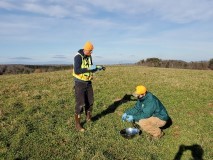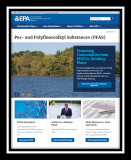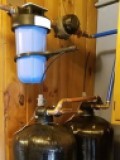Home → Spills & Site Cleanup → PFOA and PFOS
Per- and Polyfluoroalkyl Substances (PFAS)
What are PFAS? |
PFAS and Maine DEP |
PFAS and the US EPA |
PFAS Treatment and Destruction |
PFAS in Products |
PFAS Data and Guidance |
Additional Resources and Information |
Updates and Timeline |
What are PFAS?
PFAS refer to a group of man-made chemicals known as Per- and Polyfluoroalkyl Substances. There are thousands of varieties of these chemicals including the six PFAS chemicals which are included in, Resolve 2021, Chapter 82 (Resolve, To Protect Consumers of Public Drinking Water by Establishing Maximum Contaminant Levels for Certain Substances and Contaminants) and listed below:
- Perfluorooctanoic acid (PFOA)
- Perfluorooctanesulfonate (PFOS)
- Perfluorononanoic acid (PFNA)
- Perfluorohexanesulfonic acid (PFHxS)
- Perfluoroheptanoic acid (PFHpA)
- Perfluorodecanoic acid (PFDA)
As early as the 1940's, PFAS (mostly PFOA and PFOS earlier on) became widely used in household products and industrial settings. These chemicals were also historically used in firefighting foams due to their effectiveness at quickly extinguishing petroleum-based fires. Because they have a unique ability to repel oil, grease, water and heat, PFAS are used in many common products that we use regularly. For example, they have been used to make non-stick cookware, stain-resistant carpets and furniture, water-resistant clothing, heat-resistant paper/cardboard food packaging (like microwave popcorn and pizza boxes), and some personal care products. PFAS break down very slowly and are persistent in the environment. This means that PFAS may build up in people, animals, and the environment over time. Health agencies are working to understand more about the health effects of low level, long-term exposure.
PFAS have been found in several locations which may include:
- Ground and surface water (including some sources of drinking water)
- Soil
- Agricultural land and products
- Fish and wildlife
- Consumer and industrial products
- Waste materials including sludge, septage, landfill debris, and landfill leachate
- Remediation or waste clean-up sites
| Potential Health Impacts from PFAS |
|---|
| Decreases in fertility or increases in high blood pressure in pregnant women |
| Reduced ability of the body’s immune system to fight infections including reduced vaccine response |
| Child development effects including low birth weight, accelerated puberty, bone variations, or behavioral changes |
| Increased risk of some cancers including prostate, kidney, and testicular cancers |
| Interference with the body’s natural hormones |
| Increased cholesterol levels and/or risk of obesity |
PFAS and the US EPA
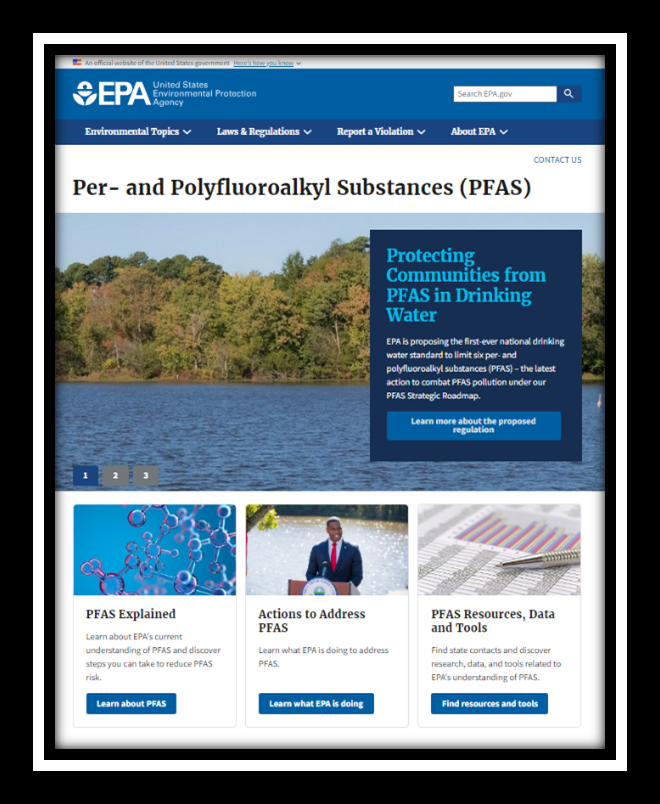 On April 27, 2021, the federal Environmental Protection Agency (EPA) Administrator Michael Regan established an EPA Council on PFAS to understand and address the risks associated with PFAS. Up until this time, EPA’s guidance for drinking water was based upon a Health Advisory (HA) for PFOA and PFOS published in May of 2016. The 2016 drinking water HA stated that when PFOA or PFOS, or both combined, were found to be above 70 nanograms per liter (or 70 ppt), actions should be taken to reduce exposure. Maine had been following this standard until June 21, 2021 when the Maine legislature adopted an interim drinking water standard in, Resolve 2021, Chapter 82, Resolve, To Protect Consumers of Public Drinking Water by Establishing Maximum Contaminant Levels for Certain Substances and Contaminants.
On April 27, 2021, the federal Environmental Protection Agency (EPA) Administrator Michael Regan established an EPA Council on PFAS to understand and address the risks associated with PFAS. Up until this time, EPA’s guidance for drinking water was based upon a Health Advisory (HA) for PFOA and PFOS published in May of 2016. The 2016 drinking water HA stated that when PFOA or PFOS, or both combined, were found to be above 70 nanograms per liter (or 70 ppt), actions should be taken to reduce exposure. Maine had been following this standard until June 21, 2021 when the Maine legislature adopted an interim drinking water standard in, Resolve 2021, Chapter 82, Resolve, To Protect Consumers of Public Drinking Water by Establishing Maximum Contaminant Levels for Certain Substances and Contaminants.
On October 18, 2021, as a result of recommendations from the EPA Council on PFAS, the EPA released a PFAS Strategic Roadmap. The roadmap set forth timelines between 2021 and 2024 by which EPA plans to take specific actions and commit to new policies in the interest of protecting public health and the environment. These actions are not limited to drinking water but include a wide variety of other environmental programs.
On April 10, 2024, EPA announced the final National Primary Drinking Water Regulation and established legally enforceable levels, called Maximum Contaminant Levels (MCLs), for six PFAS in drinking water. There are five PFAS that have individual MCLs (PFOA, PFOS, PFHxS, PFNA, and HFPO-DA), and there are a group of two or more PFAS that are evaluated together as a mixture (PFHxS, PFNA, HFPO-DA, and PFBS) using a Hazard Index to account for the combined and co-occurring levels of these PFAS in drinking water.
| Compound | EPA Final MCL (enforceable levels) |
|---|---|
| PFOA | 4.0 parts per trillion (ppt) (also expressed as ng/L) |
| PFOS | 4.0 ppt |
| PFHxS | 10 ppt |
| PFNA | 10 ppt |
| HFPO-DA (commonly known as GenX Chemicals) | 10 ppt |
| Mixtures containing two or more of: PFHxS, PFNA, HFPO-DA, and PFBS | 1 (unitless) Hazard Index |
![Hazard Index (1 unitless) = ([HFPO – DAppt] /10ppt) + ([PFBSppt] /2000ppt) + ([PFNAppt] /10ppt) + ([PFHxSppt] /10ppt)](images/equation.png)
It should be mentioned that two of the PFAS included in the EPA’s proposed MCL list are different than the PFAS regulated under Maine’s interim drinking water standard. The differences are:
| EPA Proposed MCL PFAS | Maine Interim Drinking Water Standard PFAS |
|---|---|
| PFOA | PFOA |
| PFOS | PFOS |
| PFNA | PFNA |
| PFHxS | PFHxS |
| PFBS | PFHpA |
| HFPO-DA (GenX) | PFDA |
The Maine Department of Health and Human Services has drafted a state PFAS Rule that is at least as stringent as the federal requirements. The draft rule is currently in the rule-making process, and they anticipate the rule will be adopted in 2025. The Maine State Legislature is currently evaluating how the MCL will affect the current statewide sludge and septage investigation.
PFAS Treatment and Destruction
Technology for the treatment, concentration, and destruction of PFAS is still in its early stages and currently there is no universal, cost-effective way to remove PFAS from all media. Furthermore, technologies currently available to manage PFAS vary based upon the type of media. For example, removing PFAS in water requires different considerations and processes than removing PFAS from soil, sludges, leachate, vegetables, milk, beef, or other contaminated media. This is because each media type has unique characteristics which may pose challenges with existing technology. The federal government, the State of Maine, multiple academic institutions, and private industry are researching new technologies and methods for treating, concentrating, and destroying PFAS. It is anticipated that options will be evolving rapidly over the next few years.
Treating PFAS in Drinking Water
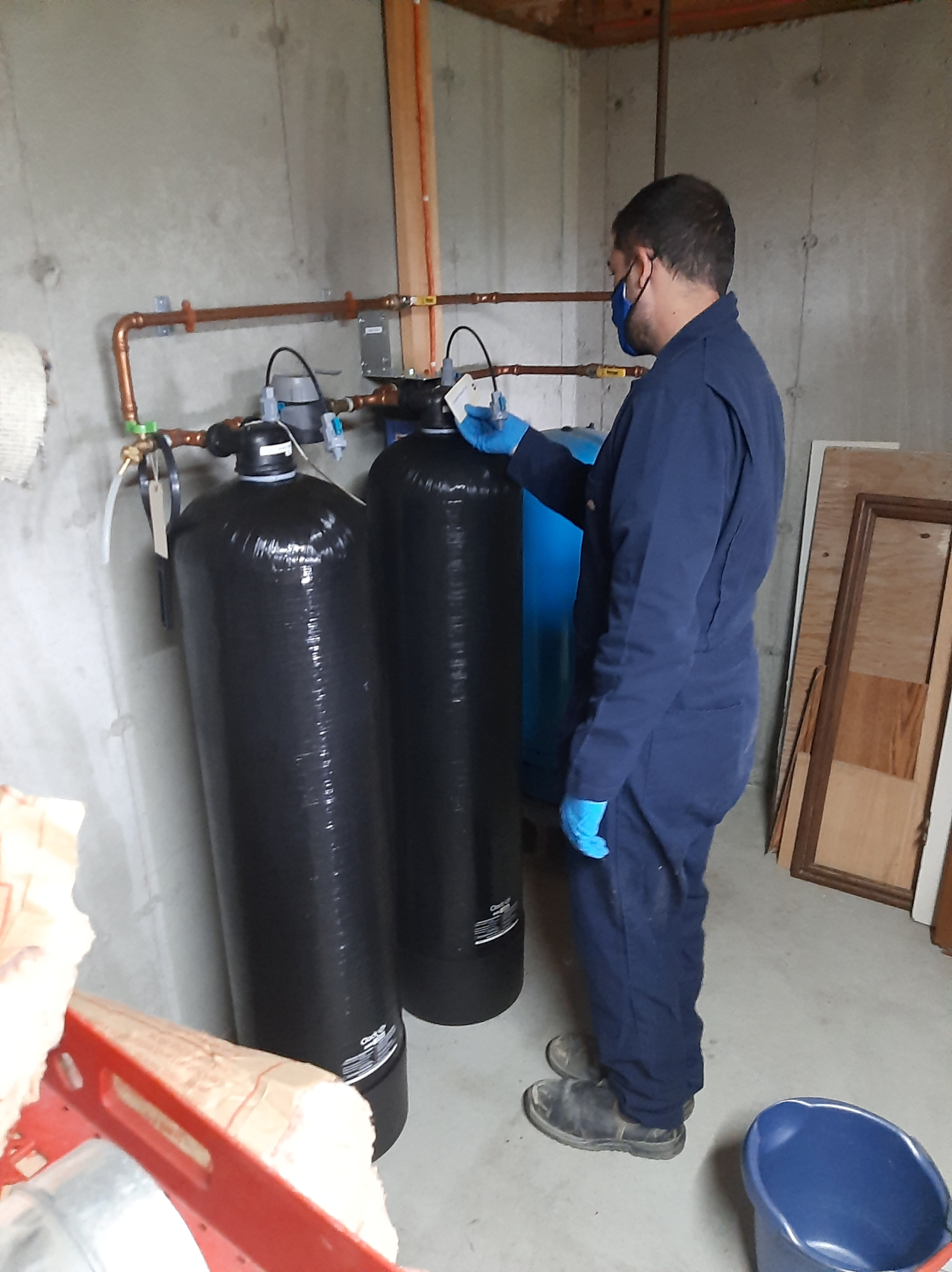 There are several widely recognized and effective methods to remove PFAS from water. The best available technologies are Granular Activated Carbon (GAC), Ion Exchange Resin (IX) and Reverse Osmosis (RO)/Nanofiltration (NF). GAC is a common water treatment method that removes PFAS from water through adsorption. IX uses specially treated resins that remove PFAS through both adsorption and ion exchange. RO and NF forces water through a filter membrane that PFAS cannot penetrate thus removing contaminants from the water supply and providing treated water to a home or faucet. Information about each of these technologies is available on the EPA website. In addition, the EPA has more information about novel technologies for PFAS treatment through its Drinking Water Treatability Database.
There are several widely recognized and effective methods to remove PFAS from water. The best available technologies are Granular Activated Carbon (GAC), Ion Exchange Resin (IX) and Reverse Osmosis (RO)/Nanofiltration (NF). GAC is a common water treatment method that removes PFAS from water through adsorption. IX uses specially treated resins that remove PFAS through both adsorption and ion exchange. RO and NF forces water through a filter membrane that PFAS cannot penetrate thus removing contaminants from the water supply and providing treated water to a home or faucet. Information about each of these technologies is available on the EPA website. In addition, the EPA has more information about novel technologies for PFAS treatment through its Drinking Water Treatability Database.
Maine residents with private drinking water wells exceeding Maine’s interim drinking water standard, as identified through the state’s soil and groundwater investigation, are provided with filtration systems to ensure their drinking water is clean and safe. Typically, Maine DEP and its consultants install GAC systems for whole house water treatment. RO and IX have also been used where appropriate but less often than GAC systems. All these systems have been shown to be effective through ongoing post-installation sampling at Maine residences. Maine DEP and other states are considering compact RO treatment systems, which can fit under a kitchen sink, for single faucet and fridge/icemaker drinking water use.
One consideration of treating PFAS in drinking water is that filter media or wastewater will contain PFAS resulting in treatment system residues or waste materials with concentrated levels of PFAS. These residues or waste materials must be properly disposed of or destroyed. PFAS in spent GAC and IX media can be destroyed through processes involving thermal treatment or other methods and then the media can be reused. RO produces spent filters and wastewater containing concentrated PFAS. The best methodologies for disposing of these waste materials are under evaluation.
Federal Research Regarding PFAS Treatment and Destruction
In 2019, the EPA issued a Technical Brief on the incineration of PFAS as a means to manage waste streams. This technical brief outlined the state of the science in 2019 and did not clearly endorse incineration as a safe or preferred method for managing PFAS waste streams. This is because some research has suggested that without complete combustion some PFAS may break down into more harmful components including other types of PFAS. In April 2022, the Pentagon halted the practice of incineration at Department of Defense (DoD) sites.
In Spring 2020, the EPA established the PFAS Innovative Treatment Team (PITT), a team of interdisciplinary staff, to evaluate options for PFAS treatment and destruction. More detail about their work is available at the above EPA website specifically pertaining to these four technology types: super critical water oxidation (SCWO), pyrolysis and gasification, mechanochemical degradation, and electrochemical oxidation.
In August 2020, the EPA Office of Innovation issued a PFAS Challenge to the nation for innovative ways to destroy PFAS. Applicants were asked to develop destruction technologies to achieve 99% destruction of PFAS in Aqueous Film Forming Foam (AFFF) formulations (i.e., fire suppressant foam). Winners of the challenge submitted proposals for the following technologies: Hydrothermal processing, Ultra violet light, and continuous flow liquid-phase plasma discharge.
Later the same year, EPA’s Office of Research and Development (ORD) presented information to Region 1 States and Tribes on PFAS Treatment and Destruction Technologies, and at the end of the year released the Interim Guidance on the Destruction and Disposal of Perfluoroalkyl and Polyfluoroalkyl Substances and Materials Containing Perfluoroalkyl and Polyfluoroalkyl Substances. The document provided information on state of science and associated uncertainties for current commercially available disposal or destruction technologies (as of late 2020).
In October 2021 the EPA released its PFAS Strategic Roadmap, which lays out their approach to addressing PFAS with annual update reports being released for three years.
In June 2022, EPA established a PFAS Thermal Treatment Database with information about the following methods of thermal treatment for PFAS:
| Type of Thermal Treatment | Description of Treatment |
|---|---|
| Calcination | A type of incineration performed on solid materials. |
| Pyrolysis | A process that decomposes materials at moderately elevated temperatures in an oxygen-free environment with the goal of producing a material for beneficial reuse (e.g., biochar, syngas). |
| Gasification | A process similar to pyrolysis that uses small quantities of oxygen, using heat from the partial combustion process to provide heat for gasification. |
| Granular activated carbon reactivation | A process that passes PFAS contaminated water through granular active carbon, or GAC to which PFAS compounds adhere. The GAC can then be thermally reactivated, removing the adsorbed contaminants, and allowing the GAC to be recycled and reused. |
| Hydrothermal processing | A process which uses high-temperature and high-pressure water to degrade PFAS compounds. |
| Incineration | A process which uses high temperature and oxygen to degrade PFAS compounds. In 2025 the EPA actively studied incineration as a destruction method using a high temperature hazardous waste incinerator. |
| Indirect thermal desorption | A process which removes PFAS from contaminated media through indirect heat without combustion. |
| Smoldering | A process which uses a slow, flameless form of combustion to degrade PFAS. |
In July of 2023, the DoD released an Interim Guidance for the Destruction or Disposal of Materials containing PFAS in the U.S. for operations of DoD facilities. DoD identified the following four commercially available options to destroy or dispose of PFAS-containing materials, in order of consideration:
- Carbon reactivation units with environmental permits (for used granular activated carbon only)
- Hazardous waste landfills with environmental permits
- Solid waste landfills with environmental permits that have composite liners, and gas and leachate collection and treatment systems
- Hazardous waste incinerators with environmental permits
In addition to the four DoD-wide options above, DoD Components are directed to consider on a site-specific basis: onsite hazardous waste storage for storage over ninety days, and underground injection control. DoD Components may also consider on a site-specific basis other existing and developing PFAS treatment or destruction technologies instead of utilizing hazardous waste incinerators that are accepted/permitted by appropriate State or Federal regulators.
In April 2024, the EPA released updated Interim Guidance on the Destruction and Disposal of PFAS-Containing Materials. The goal being to find technologies with the lowest potential for environmental release of PFAS compared to other methods. The guidance focuses on the current state of science and the associated uncertainties for three large-scale capacity technologies that can destroy PFAS or control PFAS release into the environment: thermal destruction, landfills and underground injection.
The bottom line
The bottom line is that the state of science surrounding the emerging contaminants of PFAS is evolving and is expected to advance as more entities develop and engineer new methods for treatment and destruction.
PFAS are considered to be ‘emerging contaminants’ and as such much remains to be learned about how to best manage these contaminants. At this time, many of the existing technologies are in pilot or demonstration phase only and few have been developed for large-scale use. This means that traditional disposal methods, such as landfilling, continue to be the current mechanism for PFAS management.
State of Maine Research and Collaboration Regarding PFAS Treatment and Destruction
Multiple State agencies including the Maine DEP, Department of Health and Human Services (DHHS), Department of Agriculture, Conservation and Forestry (DACF), Department of Inland Fisheries & Wildlife (DIF&W), and Department of Administration and Financial Services (DAFS) are working together to monitor and evaluate opportunities to use new technologies for treatment, concentration, and destruction of PFAS. This includes addressing concerns about sludge, septage, leachate, water, soil, milk, animal wastes, and other agricultural products. Technologies are still evolving and matching the right technology to the right location and set of circumstances, while also ensuring that funding is available to support these new technologies, is challenging. Several academic institutions and private industries have reached out to Maine’s agencies to offer support in both studying and managing PFAS in all types of media. This focus on Maine is much appreciated, and the Maine DEP continues to work with multiple entities to determine the most appropriate options for managing PFAS in Maine.
Maine is taking action to find and use readily available technologies to resolve issues surrounding statewide treatment and destruction needs quickly and within reasonable costs. The table below identifies some of the initiatives currently underway to address these issues.
| PFAS Waste Stream | Possible Treatment Technologies |
|---|---|
Drinking Water |
Maine DEP has installed and maintained private drinking water treatment systems at over 500 homes. These systems are primarily GAC; however, IX and RO have been used where beneficial. These homes had private drinking water supplies (wells) that tested above the State’s interim drinking water standard and the source of PFAS was tied to a DEP-licensed sludge or septage land application site or other remediation-type site. |
Wastewater Sludges (including septage) |
The Maine legislature was the first in the nation to ban the land application of sludge and sludge-derived products through Public Law 2021, Chapter 641, effective August 8, 2022. In a confluence of events, Maine’s ability to dispose of and manage sludge was significantly reduced in early 2023. As a result of this significant challenge, Maine DEP joined forces with the Maine Water Environment Association (MEWEA) in ongoing collaboration to conduct a joint study on sludge generation, disposal capacity, and treatment and disposal options. Brown and Caldwell was contracted to lead the study and issued a report to the DEP in December of 2023. The report recommends the Maine DEP process the application to expand Juniper Ridge Landfill in Old Town, ME in a timely manner, use other landfills where available, and study the bulking agents used to stabilize sludge in landfills. Brown and Caldwell advised the State to reconsider the sludge utilization ban using federal EPA biosolids limits once they are established. They also recommend funding PFAS destruction pilot studies as well as sludge reduction, drying, and PFAS treatment projects. Other communities and wastewater treatment facilities that generate sludge in Maine are simultaneously looking into large-scale drying centers for sludge so that sludge waste products contain less moisture. This enables easier transport of waste for landfilling and also may allow landfill operators to more easily accommodate sludge waste streams. The challenge to this technology is that the cost for setting up such a facility can be prohibitive, and funding is a concern. To assist communities with this effort the Maine DEP submitted a $50,000,000 bond request to the Legislature. A vote on this bond is expected by May of 2026. Waste Management’s Crossroads Landfill in Norridgewock was issued a solid waste license in 2024 to construct and operate an approximately 200 wet tons per day sludge processing facility. The facility is under construction, to be fully operational in 2026. It will be able to handle drying thus reducing and stabilizing 83% of the state’s annual sludge generation provided that Maine’s sludge generators contract to use this technology. The proposed sludge processing facility includes the installation of three low-temperature belt dryers using energy efficient heat pump technology. The landfill will also be providing PFAS treatment of its leachate as noted below. Anson Madison Sanitary District (AMSD) is working with ECT2, the Maine DEP, and with support from some of Maine’s Congressional Delegation to develop a regional treatment center for PFAS in sludges or liquids. This upgraded facility would be a place for the region to take waste sludges, manure wastes, and other liquid and semi-liquid wastes for PFAS treatment. The technology would be placed at the back end of the normal wastewater treatment process as a final “finishing” of effluent to ensure that effluent discharged is treated for PFAS. The project is seeking additional funding and will utilize foam fractionation when completed. York Sewer District is pursuing a 2028 pilot project using Beyond-the-Dome’s modular supercritical water oxidation technology to destroy PFAS and reduce the volume of wastewater sludge. Portland Water District (PWD) is considering solids processing technologies like mesophilic anerobic digestion, drying, and thermal treatment to reduce the amount of biosolids for disposal. This effort could also include other nearby utilities. PWD is also looking at upgrading existing dewatering and other solids handling processes at the four facilities it operates. In addition PWD is exploring advanced thermal PFAS destruction technologies, such as pyrolysis and gasification, to safely and economically reduce or eliminate PFAS from the biosolids altogether. Private industry company Aries Clean Technologies is planning to construct a facility in Sanford with proprietary gasification technology that can process over 400 tons/day of sludge (169% of state generated biosolids). This method is advertised to reduce biosolids volume by 95% and destroy PFAS. |
Milk |
In early 2021, Maine DEP and DACF recognized that milk would become a priority waste stream for farmers who learned their dairy herds were producing PFAS-contaminated milk. Volumes of waste milk would vary based on the size of the farm, but the amounts could be significant. In 2021, Brown and Caldwell, produced a Technical Memorandum for Maine DEP outlining various options for managing PFAS-impacted milk and dairy wastes (i.e., manure and process water). Also in 2021, Maine DEP contracted with ACV Environmental to conduct a pilot project for treating PFAS-impacted milk and dairy wastes from a dairy farm in Fairfield. This pilot project informed the state that milk waste is a complex media based on its elevated fat content (versus water), and that typical water filtration systems would not be effective without consideration of significant design challenges. In 2022, Maine DEP and DACF coordinated to explore a system that might be designed specifically for treating PFAS-impacted milk. Ultimately, this effort did not identify a reliable and cost-effective method. Fortunately, the amount of milk impacted by PFAS from 2023 onward has been significantly lower than in previous years; however, the Maine DEP and DACF continue to evaluate options for managing PFAS-impacted milk and work closely with any affected producers to responsibly handle waste in the absence of treatment technology. |
Beef and Animal Wastes (carcasses) |
In 2021, Maine DACF and Maine DEP performed a series of joint compost trials focusing on animal mortalities that had resulted from excessive PFAS contamination on a Central Maine dairy farm. These animals, due to their relatively advanced age, were deemed not eligible for depuration and were thus humanely euthanized. In all, 35 swine, 157 beef animals and 59 dairy cow mortalities were composted using a mixture of waste animal feed, manure and sawdust shavings. While the results did not show promise regarding reduction of PFAS compounds, the trials did show that composting could be used to treat mortalities; making them easier to handle, while reducing offensive odors and attractiveness to vectors. In 2022, Maine DEP and DIF&W began a pilot study on the composting of animal carcasses (deer, turkeys), as a result of contaminated wildlife and a further desire to study testing composting methods on these mortalities. Waste Management Disposal Services of Maine, Inc. (WMDSM) provided a location and equipment to conduct the pilot trials. The purpose of the study is to not only reduce the volume of PFAS-impacted animal wastes but also find out if the composting process can effectively reduce PFAS concentrations in order to see if compost can be made available for alternative uses (e.g., perhaps alternative daily cover for landfills). A final compost trial was conducted during summer of 2023 and included 12 adult beef animals and one calf. The results from all of the trials 2021-2023 are currently being compiled and a final report is expected mid-year in 2026. During the Fall of 2023, Maine DEP partnered with DACF, DIF&W, and researchers from Purdue University to determine whether composting could be used to manage PFAS contamination in discarded meat, culled deer and culled turkeys. Multiple compost trials were held in cooperation with Waste Management at the Crossroads Facility in Norridgewock. The trials failed to demonstrate elimination of the PFAS compounds. A second part of the study involved bench-scale testing of samples of the compost in a forced aeration system to see if PFAS compounds could be affected by this process. A final report summarizing all the trials is expected early in 2026. |
Soils |
The University of Maine (UMaine) is researching energy-efficient technology to break down PFAS in soil without harming soil health. This project will use activated carbon coated on a plasma electrode to capture PFAS from soil. After capturing sufficient PFAS onto activated carbon, plasma will be activated to break down the PFAS molecules and refresh the activated carbon. Periodically activating the plasma destroys the PFAS and refreshes the carbon's ability to capture more PFAS. The Aroostook Band of the Micmac Nation, Upland Grassroots, Connecticut Agricultural Experiment Station are looking at phytoremediation using hemp to see if hemp plant uptake of PFAS would effectively reduce levels of PFAS in the soil. Other researchers have been in communication with DEP and the University of Maine looking at phytoremediation using vegetation that acts as a hyper-accumulator other than hemp as a means to reduce PFAS levels in the soil. One of the challenges to phytoremediation is that once PFAS is removed from the soil, the plants will have concentrated levels of PFAS that must then be appropriately disposed or destroyed. UMaine is studying methods to decrease uptake of PFAS into plants on Hunter Farm in Unity. UMaine’s Maine Agricultural and Forest Experiment Station was granted access to the 150-acre formerly active farm which cultivated organic vegetable crops and forage for dairy cows until PFAS contamination was found. The research of how PFAS moves through living organisms and potential remediation techniques involves using a variety of plant species and various soil amendments to track how the PFAS chemicals uptake into a plant’s leaves, grain or seeds. |
Landfill leachate |
On September 24, 2025, PL 2025, Ch. 172, An Act to Protect Groundwater and Surface Waters from Perfluoroalkyl and Polyfluoroalkyl Substances from Landfill Leachate went into effect. This law requires PFAS in landfill leachate to be tested in accordance with facility water monitoring plans with the results reported annually on the Department’s website. The law also requires wastewater dischargers that accept leachate to maintain certain records regarding the leachate and report this information to the Maine DEP annually. The 130th legislature through PL 2022, Ch. 172 required the Bureau of General Services (BGS) to report to the legislature in 2023 on treatment options for PFAS in landfill leachate at two state owned landfills - the Juniper Ridge Landfill in Old Town, and the Dolby Landfill in East Millinocket. The final report: Study to Assess Treatment Alternatives For Reducing PFAS in Leachate From State Owned Landfills was submitted to the Maine Legislature in January 2023. Juniper Ridge Landfill in Old Town, ME, owned by the State of Maine and operated by Casella Waste Systems, Inc., is currently in the process of reviewing PFAS treatment options to fulfill a solid waste license Public Benefit Determination condition which requires the facility to design and install a DEP-approved system for the treatment of landfill leachate for PFAS prior to expansion operations (if a license is issued for the construction and operation of the expansion). Crossroads Landfill in Norridgewock, ME, owned and operated by Waste Management, issued a solid waste license in 2024 to construct and operate a leachate PFAS treatment system. The facility is under construction and is expected to be fully operational sometime in 2026. The leachate PFAS treatment system will utilize foam fractionation technology. |
PFAS Data and Guidance
Maine PFAS data (2007-2025) as of June 2025. For questions regarding this data, please email pfas.dep@maine.gov
Maine DEP PFAS Investigation Map (Formerly the “Septage and Sludge Map”). Please direct any feedback to pfas.dep@maine.gov
PFAS Water Sampling for Homeowners
PFAS Soil Sampling for Homeowners
Information for PFAS Self-testers
How to Read and Interpret my PFAS Laboratory Data Report
Background Levels of PFAS and PAHs in Maine Shallow Soils, Study Report dated April 2022
Updates and Timeline
Fairfield-Area PFAS Investigation
- For information about current deer consumption advisories, contact Maine DIFW
January 15, 2025 - Status of Maine's PFAS Soil and Groundwater Investigation at Sludge and Septage Land Application Sites [PDF] :: [Correction sheet PDF]
February 26, 2024 - Assessment of Landfill Capacity for Biosolids and Initial Evaluation of Leachate Treatment Approaches in Maine [PDF]
January 2023 – Maine Bureau of General Services, Study to Assess Treatment Alternatives for Reducing PFAS in Leachate from State-Owned Landfills
January 16, 2024 – Report on the Testing of Landfill Leachate for Perfluoroalkyl and Polyfluoroalkyl Substance Contamination [PDF]
December 15, 2023 – An Evaluation of Biosolids Management in Maine and Recommendations for the Future [PDF]
February 27, 2023 - PFAS in Maine presentation to the Maine Association of Realtors
January 13, 2023 - Status of Maine's PFAS Soil and Groundwater Investigation at Sludge and Septage Land Application Sites MAINE [PDF]
January 13, 2023 - Report on Land Application of Septage Pursuant to P.L. 2021 Chapter 641 [PDF]
January 5, 2023 - Report on the Designation of Uncontrolled Hazardous Substance Sites [PDF]
August 4, 2022 - Maine Property Tax School
June 16, 2022 - NEWMOA Board Meeting
April 1, 2022 - Maine Water Environment Association Spring Conference
March 15, 2022 - PFAS presentation to the Maine Grocers and Food Producer’s Association
January 30, 2022 - PFAS presentation to the Joint Standing Committee on the Environment and Natural Resources
January 14, 2022 - PFAS presentation at Maine Agricultural Trades Show
October 20, 2021 - PFAS Briefing to the Board of Environmental Protection
February 8, 2021 - PFAS Briefing for the Committee on Environment and Natural Resources (off-site video, briefing begins at approximately 47:50)
February 1, 2021 - Letter to EPA
November 12, 2020 - Maine sludge and bioash spreading information (Excel), please note the file contains links that will not work. Please direct any feedback to pfas.dep@maine.gov
January 2020 - Managing PFAS in Maine, Final Report from the Maine PFAS Task Force
August 14, 2019 - Emergency Sludge Dewatering State Wastewater Infrastructure Planning and Construction Grants Available
June 10, 2019 -letters from the Northeast Committee on the Environment to US Committee on Environment and Public Works and Congressional PFAS Task Force.
March 22, 2019 - The Department notified sludge/biosolids program licensees and related composting facilities of a new requirement to test for PFOA, PFOS, and PFBS. Upcoming deadlines include submission of an updated Sampling and Analytical Work Plan by April 12, 2019, and initial sampling to be conducted by May 7, 2019.
- March 22, 2019 memo re: Requirement to analyze for PFAS compounds. Includes sampling protocol and list of approved laboratories for PFAS analysis. (pdf)
- Per- and Polyfluoroalkyl Substances (PFAS) Laboratory Recommendations follow-up memo (pdf)
March 22, 2019 - DEP Announces Testing of All Sludge Materials Before Land Application
March 6, 2019 - Governor Mills Signs Executive Order Establishing Task Force Charged with Studying Effects of PFAS Prevalence in Maine
Additional Information and Resources
Maine specific information
- For general questions related to PFAS and filter system installation, please send an e-mail to pfas.dep@maine.gov
- For information about current deer consumption advisories, contact the Maine Department of inland Fisheries and Wildlife (DIF&W) at IFW.PFAS@maine.gov or call 207-287-8000.
- For health-related questions, please see this Maine CDC PFAS in Well Water Fact Sheet. For more information, visit the Maine CDC Environmental and Occupational Health Program webpage.
- For information about PFAS in agriculture, please visit the Department of Agriculture Conservation and Forestry website, send an e-mail to pfas.dacf@maine.gov, or call (207) 287-4514.
- For information about treatment of leachate at state landfills, please visit the Department of Administration and Financial Services, Bureau of General Services.
Federal Information
US Centers for Disease Control (CDC) – National Institute of Occupational Safety and Health (NIOSH)
Agency for Toxic Substances and Disease Registry
Frequently Asked Questions
- What are PFAS and how do they get into the environment?
-
PFAS refer to a group of man-made chemicals known as Per- and Polyfluoroalkyl Substances that have been used since the 1940s in numerous household and industrial products. PFAS have been used in carpets, fabrics, clothing, food packaging, pots and pans, and personal care products to repel water, resist stains and grease, and resist temperature changes. There are thousands of varieties of these chemical compounds. PFAS are persistent in the environment which means that they don't break down easily and almost everyone has some levels of these chemicals in their bodies. In the environment, PFAS has been found in residential septic systems, near airports where certain firefighting foams were used, near factories that used these chemicals, on land where the application of sludge and septage has occurred, and in landfill leachate.
- Who can I call if I have questions about how PFAS may affect my health?
-
If you have questions about blood testing or health effects from PFAS, please contact the Maine Center for Disease Control and Prevention (CDC) and ask to speak to a toxicologist at 866-292-3474 (toll-free in Maine), 207-287-4311, or Maine Relay 711. If you are concerned about a known PFAS exposure, it is best to talk with your doctor to decide whether to test for these chemicals.
- Why did the land application of sludge and septage lead to elevated levels of PFAS?
-
Sludge and septage are created as a result of what goes down the drain. Many products that we use in our daily lives contain PFAS, and therefore a certain level of PFAS goes down the drain into our wastewater. During the process of treating wastewater, PFAS can be concentrated in the resulting sludge. Household activities such as washing laundry or textiles that contain PFAS, or cleaning non-stick pans made with PFAS are just two examples of how PFAS can easily get into our wastewater stream. Since the late 1970’s sludge and septage waste streams were often land applied as a beneficial method for adding nutrients back into the soil. Land application of sludge or sludge-derived products occurred commonly at farms or areas used for landscaping throughout the United States and was perceived as a positive practice. In Maine these practices were licensed to ensure that concentrations of metals or other organic compounds did not compromise soil health. PFAS were not taken into consideration as part of the licensing process until 2019 as it was not fully understood before then that PFAS in sludge could impact public health and the environment.
- How does DEP decide where to sample wells?
-
When deciding which wells to sample, the Department considers site-specific information including known or potential sources of PFAS contamination, direction of groundwater flow, and the private drinking water well’s proximity to licensed land application sites.
- Why has my neighbor's well been sampled but not mine?
-
There may be a few reasons why your neighbor’s well was sampled, but your residence was not. Your well may be just outside an area of investigation and results of nearby wells that were part of the investigation may have shown that PFAS were not detected. It also could mean that your well may not have been included in the most recent round of sampling but may be sampled in the near future. DEP has established a prioritization system to decide where to sample for PFAS contamination in wells. First, DEP takes into consideration information about known or potential sources of PFAS, soils, the direction of groundwater flow, and existing test results to determine the areas that are likely to have the highest potential risk. Once these areas are identified, DEP conducts a phased approach to sampling which may be broadened over time based on an evaluation of results. This means that sampling starts closest to the areas identified as highest potential risk, and then the radius of investigation is expanded as needed. How far out the sampling continues is based on an evaluation of results including whether there have been any exceedances of the standard. If sample results get lower and lower as sampling continues outward, sampling will be reduced.
- DEP has not identified my well as at risk. Can I sample my own water supply?
Yes, DEP encourages homeowners that are interested to sample their own water supply if certain sampling protocols are followed, and a Maine-certified laboratory is used. Specific sampling requirements must be followed to avoid potential cross-contamination of the sample. Please read DEP's PFAS Water Sampling for Homeowners or email the DEP with questions or to obtain technical assistance.
- What happens if PFAS is detected in my water?
-
In locations where it is determined that concentrations of PFAS in private drinking water wells exceed Maine’s interim drinking water standard for the sum of 6 PFAS (PFOA, PFOS, PFNA, PFHxS, PFHpA, and PFDA), and contamination can be tied to a DEP-licensed sludge or septage land application site or other remediation-type sites, DEP will work with homeowners to ensure that they have clean water to drink. In these circumstances, DEP will provide homeowners with bottled water until a filtration system can be installed and determined to be effective. A Project Manager will be in touch with you to determine how much bottled water needs to be delivered to your home and to begin the process of getting a filtration system installed.
- What type of water filtration system will be installed?
-
As an interim measure until an alternative approach is available, and subject to available funding, the Department will pay for the installation and maintenance of filtration systems on private residential water supplies, and certain other water supplies, where the DEP can link contamination to the land application of sludge or septage or other remediation-type sites. Filtration systems will generally consist of either two granular activated carbon treatment units or ion exchange resin-based treatment units with a water meter. Water softener systems may also be installed to maintain appropriate treatment depending on each home's specific water quality.
- Who is paying for the filtration systems and their maintenance?
-
Subject to available funding, DEP is paying for the installation and maintenance of the filtration systems for private residential water supplies and certain other water supplies where Maine's interim drinking water standard has been exceeded and DEP can link contamination to the land application of sludge or septage or other remediation-type sites. DEP is pursuing additional funding and other remedies for a long-term sustainable strategy and to ensure affected homeowners have safe water to drink.
- Why does DEP need to keep sampling after a filter is installed?
-
The DEP will regularly monitor the effectiveness of the systems in treating PFAS and provide the results to each homeowner. Sampling ports will be added to the system so water can be sampled in multiple locations: before entering the first filter, between the two filters, and after the water exits the filtration system to verify that the system is working correctly and effectively.
Depending on the initial concentration of PFAS in your well, the DEP will generally sample on a quarterly or semi-annual basis for a year or so to get an understanding of how the filter system works to reduce the concentrations of PFAS. This may seem like a lot of samples, but the results will determine how well the system is operating and how often the filter media will need to be changed over time. After the first year of sampling, a different frequency may be developed to monitor the filtration system over the long-term. - Who will maintain or fix my filtration system if something is wrong?
-
Maintenance of the system will be conducted periodically by DEP or by its designated contractor based on a review of periodic sampling data. Maintenance will occur based upon availability of funding and may include repairing or replacing components of the treatment system to ensure it is operating effectively.
Where appropriate and so long as funding is available, the DEP or its designated contractor will provide salt for water softeners and spare sediment filters. The property owner may assume responsibility for some routine maintenance, such as adding salt for water softeners and changing sediment filters as needed.
Responsibilities for maintenance are outlined in the Water Treatment System Filter Agreement that each homeowner is required to sign in order to obtain installation, maintenance, and management of its filtration system.
- Why do I need to sign a Filter Agreement?
-
Property owners are required to sign a Water Treatment System Filter Agreement. The agreement outlines the basic responsibilities of both the property owner as well as the DEP and it grants the DEP access to monitor and maintain the filtration systems. The agreement protects both DEP and the homeowner by establishing clear and consistent expectations that both parties must follow to ensure an effective treatment system is installed, monitored, and maintained.
- A filter system was just installed at my home. When can I start drinking the water?
-
Once a filtration system has been installed, DEP will collect water samples to demonstrate that your water is safe to drink. If you elected to receive bottled water delivery, that will continue until DEP informs you that your treatment system is working properly. Bottled water delivery will then be discontinued.
- I'm hearing that some of the filtration systems might not be working correctly. What does that mean?
-
The effectiveness of a filtration system depends on many different factors including input contaminant concentrations, water use, filter size, and type of filter. In general, the filter systems being installed are dual stage carbon filters. This means that two canisters filled with carbon are being installed so that contaminant concentrations can be monitored before the first filter, after going through the first filter (between sample), and after going through the second filter. This is all done before the water is deemed safe to drink. The between sample is able to tell us whether any type of contaminant will breakthrough through the first filter and helps us to decide when to replace the filter media. In a few systems, the filter media has had to be replaced at a more frequent schedule than anticipated; however, the sample taken after the second filter shows the water is still safe to drink. This stresses the importance of monitoring and maintaining a system regularly.
- I'm interested in buying land in an area that has been identified as impacted. Will DEP pay for the installation of a filtration system if I install a well and it needs treatment?
-
The DEP's current focus is on providing safe water to drink for those households that already have wells installed and are drinking impacted water. DEP can provide technical assistance to you if you’re concerned about installing a well in a particular area or if you would like general information about the kinds of DEP-licensed sites near your property. Please email us with your questions. - My well tested below the interim drinking water standard but I'd still like to have a filtration system installed. Where can I get information about installing my own system?
-
There are several water treatment vendors throughout Maine that install systems to treat for PFAS. The Maine Center for Disease Control and Prevention lists several water treatment professionals on their website.
While DEP is not able to provide a recommendation for a particular vendor, there are a few considerations for selection including treatability and certification. EPA's Drinking Water Treatability Database is a useful tool that provides information on the control of contaminants in drinking water. You can use the database to search for PFAS and evaluate the different treatment processes that have been shown to be effective in treatment for several different kinds of PFAS.
The National Sanitation Foundation (NSF) certifies filters that can reduce two PFAS compounds, PFOA and PFOS. NSF is an independent, accredited organization that tests and certifies products and systems to protect and improve human health. To find products certified for reduction of PFOA and PFOS by NSF International, visit NSFs certification listings. NSF International verifies that the contaminant reduction claims for PFOA and PFOS shown on the label are true; the system does not add anything harmful to the water; the system is structurally sound; and the product labeling, advertising, and literature are not misleading.
- Can DEP test my garden soil?
-
DEP understands that homeowners may have concerns about eating vegetables grown in or near at-risk areas; however, our current focus is to provide safe drinking water for homeowners with impacted wells. Because there is limited funding, DEP is not providing testing services for residential garden soil at this time. However, DEP has developed a Homeowner’s Guide to Soil Sampling for PFAS. Homeowners can conduct their own sampling, but generally the DEP encourages homeowners work with an environmental professional to ensure they get the most useful site-specific results possible.
- How do I evaluate my PFAS in Soil Results?
-
Evaluating and addressing PFAS impacts in soil can be more challenging than evaluating and addressing PFAS contamination in drinking water. This is because there is no single soil standard to compare against to determine whether levels of PFAS are safe or unsafe in soil. In order to evaluate whether PFAS poses a health or environmental risk in soil, the function and use of property must be considered. For example, if a property is used for agriculture, the impacts of PFAS in soil are likely to be very different than the impacts of PFAS in soils that are located on property associated with industrial activity. Because the function and use of properties vary, each location must be evaluated on a case-by-case basis to determine the likelihood and possibilities for exposure as well as impacts to the environment. As a starting point, the DEP assesses the known and anticipated use and function of the soil in a location that has been sampled, and compares results against DEP’s Remedial Action Guidelines (RAGs), which are guidelines (non-enforceable) to evaluate whether contaminants at certain levels are likely to pose a risk to human health or the environment given specific exposure scenarios. RAGs are derived using scientifically accepted toxicological values and are reviewed carefully in conjunction with the Maine CDC, the state’s experts on health and exposure risks.
After a site has been sampled and evaluated against the RAGs, where levels of PFAS are elevated, the DEP will share information with the property owner(s) and other appropriate state agencies to help determine if additional steps need to be taken. For example, information about PFAS in soil at active farms is shared with the Department of Agriculture, Conservation and Forestry’s PFAS program. Information about other soils that may pose risks of exposure may be shared with the Maine CDC, or other appropriate state agencies.
- I have an active farm. What happens if DEP testing shows that groundwater or soil is impacted with PFAS?
-
At active farms, DEP will share soil and groundwater test data with the Maine Department of Agriculture, Conservation and Forestry. They will then determine whether agricultural-specific sampling is warranted.
- Who should I call if I have questions about PFAS uptake in vegetables?
-
If you have questions about PFAS in your vegetables, please contact the Maine CDC at 866-292-3474 (toll-free in Maine), 207-287-4311, or Maine Relay 711 and ask to speak to a toxicologist who can explain more about the uptake of PFAS in plants.

